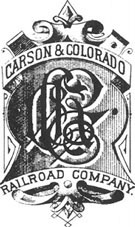Rhodes
In 1862 salt was discovered on the Virginia Salt Marsh (now Rhodes Salt Marsh) and camels were used to transport this salt to mills on the Comstock. Prior to this, salt was obtained from San Francisco at a high cost. The nearer source at Rhodes became utilized, although discoveries at Sand Springs in Churchill County would become favored a year later. Rhodes would later supply salt to Aurora, Belleville, Belmont, and other camps nearby. It was also used as a stop on the Wadsworth-Columbus Freight Route from 1876 until 1882.
By 1881 extensive salt and borax mining had been done at the marsh, and in 1882 Rhodes became a station on the Carson & Colorado Railroad. Rhodes continued to supply salt to mines in the region, and gained a post office on October 2, 1893. The Rhodes Salt & Borax Company operated sometime into this century, and the post office lasted until 1911; although for a period in 1907-08 its name was changed to Dea.
In 1928 a chemical engineer named P.S. Williams began looking at the Rhodes Salt Marsh as a source of sodium sulphate. He and a group of men from San Francisco organized the Rhodes Alkali & Chemical Corporation and in April 1930 acquired the marsh from Harrington Betty of the Rhodes Salt & Borax Company. The first plant started operation shortly thereafter, but was initially unsuccessful. A new plant was built in 1932 to recover thenardite at a rate of 150 tons per day. It operated until 1933, and production of sodium sulphates is estimated at 20,000 tons.
Rhodes has remained idle since, and the railroad tracks were removed in 1949. A salt loading tower, likely from the 1800s, stood at the site until at least late 2015, but has since collapsed.
































